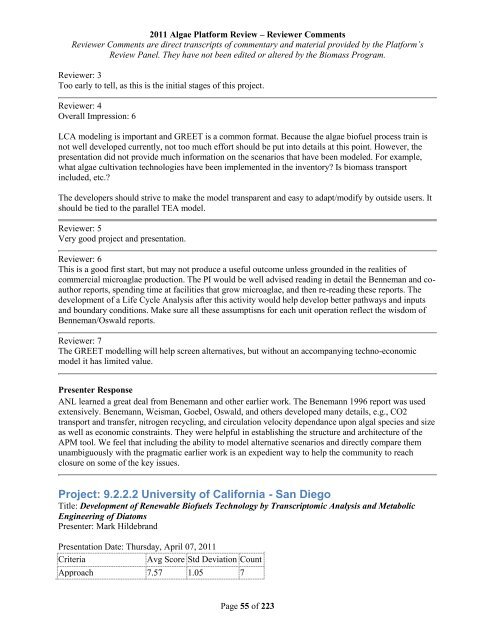Reviewer Comments - EERE
Reviewer Comments - EERE
Reviewer Comments - EERE
Create successful ePaper yourself
Turn your PDF publications into a flip-book with our unique Google optimized e-Paper software.
2011 Algae Platform Review – <strong>Reviewer</strong> <strong>Comments</strong><br />
<strong>Reviewer</strong> <strong>Comments</strong> are direct transcripts of commentary and material provided by the Platform’s<br />
Review Panel. They have not been edited or altered by the Biomass Program.<br />
<strong>Reviewer</strong>: 3<br />
Too early to tell, as this is the initial stages of this project.<br />
<strong>Reviewer</strong>: 4<br />
Overall Impression: 6<br />
LCA modeling is important and GREET is a common format. Because the algae biofuel process train is<br />
not well developed currently, not too much effort should be put into details at this point. However, the<br />
presentation did not provide much information on the scenarios that have been modeled. For example,<br />
what algae cultivation technologies have been implemented in the inventory? Is biomass transport<br />
included, etc.?<br />
The developers should strive to make the model transparent and easy to adapt/modify by outside users. It<br />
should be tied to the parallel TEA model.<br />
<strong>Reviewer</strong>: 5<br />
Very good project and presentation.<br />
<strong>Reviewer</strong>: 6<br />
This is a good first start, but may not produce a useful outcome unless grounded in the realities of<br />
commercial microaglae production. The PI would be well advised reading in detail the Benneman and coauthor<br />
reports, spending time at facilities that grow microaglae, and then re-reading these reports. The<br />
development of a Life Cycle Analysis after this activity would help develop better pathways and inputs<br />
and boundary conditions. Make sure all these assumptisns for each unit operation reflect the wisdom of<br />
Benneman/Oswald reports.<br />
<strong>Reviewer</strong>: 7<br />
The GREET modelling will help screen alternatives, but without an accompanying techno-economic<br />
model it has limited value.<br />
Presenter Response<br />
ANL learned a great deal from Benemann and other earlier work. The Benemann 1996 report was used<br />
extensively. Benemann, Weisman, Goebel, Oswald, and others developed many details, e.g., CO2<br />
transport and transfer, nitrogen recycling, and circulation velocity dependance upon algal species and size<br />
as well as economic constraints. They were helpful in establishing the structure and architecture of the<br />
APM tool. We feel that including the ability to model alternative scenarios and directly compare them<br />
unambiguously with the pragmatic earlier work is an expedient way to help the community to reach<br />
closure on some of the key issues.<br />
Project: 9.2.2.2 University of California - San Diego<br />
Title: Development of Renewable Biofuels Technology by Transcriptomic Analysis and Metabolic<br />
Engineering of Diatoms<br />
Presenter: Mark Hildebrand<br />
Presentation Date: Thursday, April 07, 2011<br />
Criteria Avg Score Std Deviation Count<br />
Approach 7.57 1.05 7<br />
Page 55 of 223




